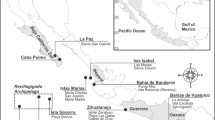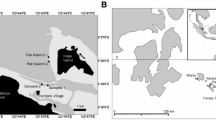Abstract
The recent increase in abundance of coral-excavating sponges is a threat to the health of coral reefs. However, the distribution and growth of these sponges are poorly documented on high latitude reefs where corals live in marginal environmental conditions. In this study, we characterize the current trends of space occupation of Cliona delitrix on high latitude reefs (26°N) in southeast Florida. C. delitrix densities were significantly higher on the deepest habitat of this reef tract (the outer reef) in response to a higher availability of coral substratum. Sponge growth rates increased with depth, and in relation to presence of tunicates and absence of macroalgae living in the sponge–coral interaction band. Conversely, coral tissue loss was similar between habitats, regardless of the fouling organisms present in the band between sponge and coral. On high latitude reefs, C. delitrix preferred massive scleractinian coral species as substratum, similar to tropical reefs, but its inclination for specific coral species varied. The outer reef sites (deepest habitat) are most vulnerable to C. delitrix colonization. Reef habitats with higher coral densities and more available dead coral may continue to suffer the greatest levels of sponge bioerosion.






Similar content being viewed by others
References
Alvarez, B., M. Díaz & R. Laughlin, 1990. The sponge fauna on a fringing coral reef in Venezuela, I: composition, distribution, and abundance. In Rützler, K. (ed.), 3th International Conference on the Biology of Sponges: New Perspective in Sponge Biology. Smithsonian Institution Press, Washington, DC: 358–366.
Banks, K. E., B. M. Riegl, V. P. Richards, B. E. Walker, K. P. Helmle, L. K. B. Jordan, J. Phipps, M. Shivji, R. E. Spieler & R. E. Dodge, 2008. Chapter 5: the reef tract of continental Southeast Florida (Miami-Dade, Broward, and Palm Beach Counties, USA). In Riegl, B. & R. E. Dodge (eds), Coral Reefs of the USA. Springer, Berlin: 175–220.
Bell, J. J., S. K. Davy, T. Jones, M. W. Taylor & N. S. Webster, 2013. Could some coral reefs become sponge reefs as our climate changes? Global Change Biology 19(9): 2613–2624.
Buddemeier, R. W., 1997. Symbiosis: making light work of adaptation. Nature 388(6639): 229–230.
Carballo, J. L., E. Bautista, H. Nava, J. A. Cruz-Barraza & J. A. Chavez, 2013. Boring sponges, an increasing threat for coral reefs affected by bleaching events. Ecology and Evolution 3(4): 872–886.
Chaves-Fonnegra, A., 2014. Increase of excavating sponges on Caribbean coral reefs: reproduction, dispersal and coral deterioration. Doctoral Dissertation. Nova Southeastern University, Oceanographic Center, Dania Beach: 195 pp.
Chaves-Fonnegra, A. & S. Zea, 2011. Coral colonization by the encrusting excavating Caribbean sponge Cliona delitrix. Marine Ecology 32: 162–173.
Chaves-Fonnegra, A., S. Zea & M. L. Gómez, 2007. Abundance of the excavating sponge Cliona delitrix in relation to sewage discharge at San Andrés Island, SW Caribbean, Colombia. Boletín de Investigaciones Marinas y Costeras 36: 63–78.
Chaves-Fonnegra, A., K. A. Feldheim, J. Secord & J. V. Lopez, 2015. Population structure and dispersal of the coral-excavating sponge Cliona delitrix. Molecular Ecology 24(7): 1447–1466.
Chiappone, M., L. M. Rutten, S. L. Miller & D. W. Swanson, 2007. Large-scale distributional patterns of the encrusting and excavating sponge Cliona delitrix Pang on Florida Keys coral substrates, Porifera research: biodiversity, innovation and sustainability. In Proceedings of 7th International Sponge Symposium, Ft. Lauderdale, FL: 255–263.
Cortés, J., M. Murillo, H. M. Guzmán & J. Acuña, 1984. Pérdida de zooxantelas y muerte de corales y otros organismos arrecifales en el Caribe y Pacífico de Costa Rica. Revista de Biología Tropical 32: 227–231.
Crawley, M. J., 2007. The R Book. Wiley, West Sussex: 942.
Duckworth, A. R. & B. J. Peterson, 2013. Effects of seawater temperature and pH on the boring rates of the sponge Cliona celata in scallop shells. Marine Biology 160(1): 27–35.
Enochs, I. C., D. P. Manzello, R. D. Carton, D. M. Graham, R. Ruzicka & M. A. Collela, 2015. Ocean acidification enhances the bioerosion of a common coral reef sponge: implications for the persistence of the Florida Reef Tract. Bulletin of Marine Science 91(2): 2015. doi:10.5343/bms.2014.1045.
Finkl, C. W. & R. H. Charlier, 2003. Sustainability of subtropical coastal zones in southeastern Florida: challenges for urbanized coastal environments threatened by development, pollution, water supply, and storm hazards. Journal of Coastal Research 19(4): 934–943.
Finkl, C. W. & C. Makowski, 2013. The Southeast Florida Coastal Zone (SFCZ): a cascade of natural, biological, and human-induced hazards. In Finkl, C. W. (ed.), Coastal Hazards. Springer, Dordrecht: 3–56.
Gerrodette, T. & A. Flechsig, 1979. Sediment-induced reduction in the pumping rate of the tropical sponge Verongia lacunosa. Marine Biology 55(1): 103–110.
Gilliam, D. S., 2012. Southeast Florida Coral Reef Evaluation and Monitoring Project 2011. Year 9 Final Report. Florida DEP Report #RM085, Miami Beach, FL: 49 pp.
Gilliam, D. S., V. Brinkhuis, R. Ruzicka & C. J. Walton, 2013. Southeast Florida Coral Reef Evaluation and Monitoring Project 2012 Year 10 Final Report. Florida DEP Report #RM085, Miami Beach, FL: 53 pp.
Holmes, K. E., 1997. Eutrophication and its effect on bioeroding sponge communities. In Lessios, H. A. & I. G. Macintyre (eds), Proceedings of the 8th International Coral Reef Symposium. Smithsonian Tropical Research Institute, Balboa: 1411–1416.
Jordan, L., K. Banks, L. Fisher, B. Walker & D. Gilliam, 2010. Elevated sedimentation on coral reefs adjacent to a beach nourishment project. Marine Pollution Bulletin 60(2): 261–271.
Kleypas, J. A., J. W. McManus & L. A. B. Menez, 1999. Environmental limits to coral reef development: where do we draw the line? American Zoologist 39: 146–159.
Leichter, J. J., G. Shellenbarger, S. J. Genovese & S. R. Wing, 1998. Breaking internal waves on a Florida (USA) coral reef: a plankton pump at work? Marine Ecology Progress Series 166: 83–97.
Lesser, M. P., 2006. Benthic–pelagic coupling on coral reefs: feeding and growth of Caribbean sponges. Journal of Experimental Marine Biology and Ecology 328(2): 277–288.
Logan, A., 1984. Interespecific aggression in hermatypic corals from Bermuda. Coral Reefs 3: 131–138.
López-Victoria, M. & S. Zea, 2004. Storm-mediated coral colonization by an excavating Caribbean sponge. Climate Research 26: 251–256.
López-Victoria, M. & S. Zea, 2005. Current trends of space occupation by encrusting excavating sponges on Colombian coral reefs. Marine Ecology 26(1): 33–41.
López-Victoria, M., S. Zea & E. Weil, 2006. Competition for space between encrusting excavating Caribbean sponges and other coral reef organisms. Marine Ecology Progress Series 312: 113–121.
Manly, B., L. McDonald, D. Thomas, T. L. McDonald & W. P. Erickson, 2007. Resource Selection by Animals: Statistical Design and Analysis for Field Studies. Springer, New York: 222.
Moyer, R. P., B. Riegl, K. Banks & R. E. Dodge, 2003. Spatial patterns and ecology of benthic communities on a high-latitude South Florida (Broward County, USA) reef system. Coral Reefs 22(3): 447–464.
Mueller, B., J. M. de Goeij, M. J. Vermeij, Y. Mulders, E. van der Ent, M. Ribes & F. C. van Duyl, 2014. Natural diet of coral-excavating sponges consists mainly of dissolved organic carbon (DOC). PLoS ONE 9(2): e90152.
Pang, R. K., 1973. The systematics of some Jamaican excavating sponges (Porifera). Postilla of the Peabody Museum of Natural History at Yale University 161: 1–75.
Perry, C. T. & P. Larcombe, 2003. Marginal and non-reef-building coral environments. Coral Reefs 22: 427–432.
Peters, E. C., 1984. A survey of cellular reactions to environmental stress and disease in Caribbean scleractinian corals. Helgoländer Meeresuntersuchungen 37(1–4): 113–137.
R Core Team, 2015. R: A Language and Environment for Statistical Computing. R Foundation for Statistical Computing, Vienna. http://www.R-project.org/.
Rützler, K., 2002. Impact of crustose clionid sponges on Caribbean reef corals. Acta Geologica Hispánica 37(1): 61–72.
Sammarco, P. P. & M. M. Risk, 1990. Large-scale patterns in internal bioerosion of Porites: cross continental shelf trends on the GBR. Marine Ecology Progress Series 59: 145–156.
Schmahl, G. P., 1991. Community structure and ecology of sponges associated with four Southern Florida Coral reefs. In Rützler, K. (ed.), New Perspectives in Sponge Biology. Smithsonian Institution Press, Washington, DC: 376–383.
Schönberg, C. H. L., 2001. Small-scale distribution of Australian bioeroding sponges in shallow water. Ophelia 55: 39–54.
Schönberg, C. H. L., 2003. Sustrate effects on bioeroding demosponge Cliona orientalis, 2. Substrate colonisation and tissue growth. Marine Ecology 24(1): 59–74.
Schönberg, C. H. L., 2008. A history of sponge erosion: from past myths and hypotheses to recent approaches. In Wisshak, M. & L. Tapanila (eds), Current Developments in Bioerosion. Springer, Berlin: 165–202.
Schönberg, C. H. L. & J.-C. Ortiz, 2008. Is sponge bioerosion increasing? In 11th International Coral Reef Symposium, Ft. Lauderdale: 520–523.
Smith, N. P., 1982. Upwelling in Atlantic shelf waters of South Florida. Florida Scientist 45(2): 117–125.
Stubler, A. D., B. T. Furman & B. J. Peterson, 2014. Effects of pCO2 on the interaction between an excavating sponge, Cliona varians, and a hermatypic coral, Porites furcata. Marine Biology 161(8): 1851–1859.
Trussell, G. C., M. P. Lesser, M. R. Patterson & S. J. Genovese, 2006. Depth-specific differences in growth of the reef sponge Callyspongia vaginalis: role of bottom-up effects. Marine Ecology Progress Series 323: 149–158.
van Soest, R., 2013. Cliona delitrix Pang, 1973. In van Soest, R. W. M., N. Boury-Esnault, J. N. A. Hooper et al. (eds), World Porifera Database. http://www.marinespecies.org/porifera/porifera.php?p=taxdetails&id=170437. Accessed on 25 March 2014.
Walker, B. K., B. Riegl & R. E. Dodge, 2008. Mapping coral reef habitats in southeast Florida using a combined technique approach. Journal of Coastal Research 24: 1138–1150.
Ward-Paige, C. A., M. J. Risk, O. A. Sherwood & W. C. Jaap, 2005. Clionid sponge surveys on the Florida Reef Tract suggest land-based nutrient inputs. Marine Pollution Bulletin 51: 570–579.
Wilkinson, C. R. & A. C. Cheshire, 1988. Growth rate of Jamaican coral reef sponges after Hurricane Allen. The Biological Bulletin 175(1): 175–179.
Williams, E. H., P. J. Bartels & L. Bunkley-Williams, 1999. Predicted disappearance of coral-reef ramparts: a direct result of major ecological disturbances. Global Change Biology 5: 839–845.
Wisshak, M., C. H. L. Schönberg, A. Form & A. Freiwald, 2012. Ocean acidification accelerates reef bioerosion. Public Library of Science One 7(9): 1–8.
Wisshak, M., C. H. L. Schönberg, A. Form & A. Freiwald, 2014. Sponge bioerosion accelerated by ocean acidification across species and latitudes? Helgoland Marine Research 68(2): 253–262.
Zilberberg, C., M. Maldonado & A. M. Solé-Cava, 2006. Assessment of the relative contribution of asexual propagation in a population of the coral-excavating sponge Cliona delitrix from the Bahamas. Coral Reefs 25: 297–301.
Acknowledgements
The authors thank the various members of the CRRAM lab at Nova Southeastern University who helped with fieldwork (C. Walton, M. Lopez-Padierna, L. Larson, C. Bliss, J. Mellein, S. Bush, Z. Ostroff, P. Espitia, N. D’Antonio, L. Kabay, K. Correia, and K. Cucinotta) and Dr. Joana Figueiredo for her feedback on the manuscript. This manuscript was submitted as partial fulfillment of the MSc degree to A.A. Halperin at Nova Southeastern University.
Author information
Authors and Affiliations
Corresponding author
Additional information
Handling editor: Vasilis Valavanis
Rights and permissions
About this article
Cite this article
Halperin, A.A., Chaves-Fonnegra, A. & Gilliam, D.S. Coral-excavating sponge Cliona delitrix: current trends of space occupation on high latitude coral reefs. Hydrobiologia 790, 299–310 (2017). https://doi.org/10.1007/s10750-016-3042-x
Received:
Revised:
Accepted:
Published:
Issue Date:
DOI: https://doi.org/10.1007/s10750-016-3042-x




